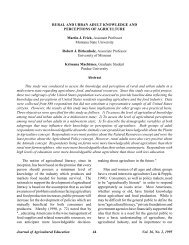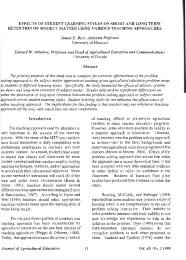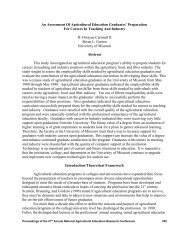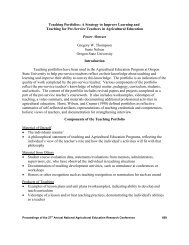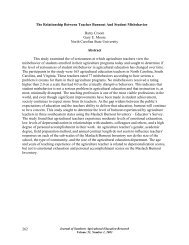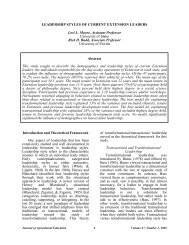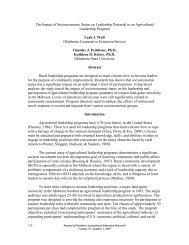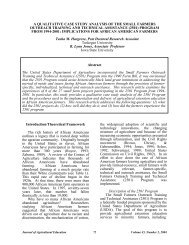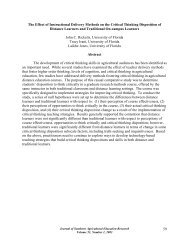Relationships Between Critical and Creative Thinking - Agricultural ...
Relationships Between Critical and Creative Thinking - Agricultural ...
Relationships Between Critical and Creative Thinking - Agricultural ...
You also want an ePaper? Increase the reach of your titles
YUMPU automatically turns print PDFs into web optimized ePapers that Google loves.
<strong>and</strong> educational setting. Isaacs (1987) examined the importance of learning style <strong>and</strong> its impacton creativity when she stated:In some ways creativity is as delicate as the very breath of life. It can be nurtured <strong>and</strong>expended, or starved <strong>and</strong> diminished. Thus underst<strong>and</strong>ing <strong>and</strong> applying findings fromlearning style study is as important for sustaining creativity as for stimulating academicachievement. (p.257)Underst<strong>and</strong>ing the manner in which the individual learns facilitates academic achievement <strong>and</strong>can lead to an environment that enhances creativity.In discussing the impact of knowledge on creativity Sternberg <strong>and</strong> Luppart (1991) made thedistinction between knowledge <strong>and</strong> usable knowledge. They stated: “knowledge can be learnedin a way that makes it inert" (p. 610). Sternberg <strong>and</strong> Luppart (1991), when discussing theimportance of motivation, identified two key types: Intrinsic motivation <strong>and</strong> the motivation toexcel. Intrinsic motivation was seen as an important element because students are much morelikely to be creative if they enjoy what they are doing. Motivation to excel has been emphasizedbecause these individuals are willing to work for creative excellence.In the book The Nature of Creativity (1997) Torrance reviewed experiments that examinedthe effects of educational setting upon creativity. The majority of the research (Boersman <strong>and</strong>O’Bryan , 1968; Moham, 1970; Hooper <strong>and</strong> Powell, 1971; Nash, 1971; Ward, 1969; Norton ,1971; Khatena, 1971; <strong>and</strong> Kogan <strong>and</strong> Morgan, 1969) found that there was a difference increativity when the school environment (testing conditions, cue rich <strong>and</strong> cue poor, etc.) wasmanipulated. These findings were in contrast to studies by Alliotti (1969) <strong>and</strong> Towell (1972)who did not find any differences in creativity based upon changes in educational environments.The core of the gestation phase of the creative process model is the creative attributesreferred to by Torrance et al. (1990) as creative thinking abilities. These creative attributes werefluency, flexibility, originality, elaboration, abstractness of the title, resistance to closure,emotional expressiveness, articulateness, movement or action, expressiveness, synthesis orcombination, unusual visualization, internal visualization, extending or breaking the boundaries,humor, richness of imagery, colorfulness of imagery, <strong>and</strong> fantasy. The Torrance Test of <strong>Creative</strong><strong>Thinking</strong> (TTCT) is an instrument that can be used to operationalize these creative attributes.This process may or may not be linear. Each iteration is different in time <strong>and</strong> shape,depending on its interaction with the other catalysts <strong>and</strong> inhibitors described in the model. It iseven possible that a full iteration may not be completed because of factors such as motivation.The final phase of this model results in an end product <strong>and</strong> verification of creativity that isexpressive in problem solution <strong>and</strong> verification for the typologies (of creativity) proposed byTaylor (1958). However it is important to point out that there is a very important time dimensionto creativity. The time dimension is influenced by the perceived importance of the problem, aswell as the motivation, support, <strong>and</strong> resources available for problem resolution.178 Journal of Southern <strong>Agricultural</strong> Education ResearchVolume 51, Number 1, 2001




